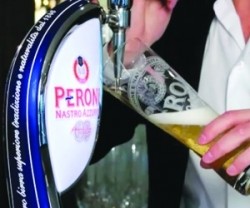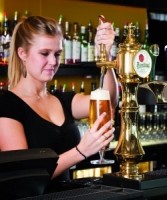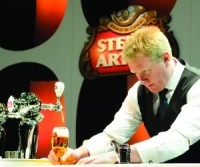Training tips: Quality of beer serve

And more likely than not, that lager is one of the estimated five billion pints of beer served each year in the UK by untrained barstaff.
With pub beer sales down nearly 3.5% in 2011, according to the British Beer & Pub Association (BBPA), pubs can ill afford to lose customers through poor service. It’s little wonder, then, that the big breweries are pushing their training programmes as never before.
They argue that a modest investment in time, and in some cases money, can result in a significant upturn in sales, a reduction in wastage and, ultimately, an improved bottom line.
“It’s amazing the care barstaff take to mix a gin and tonic, but they do not give the same level of attention in their beer presentation,” says Molson Coors UK field sales director John Clements, whose 55-strong team makes 70,000 visits to pubs, bars and restaurants up and down the country each year.
“Given that beer represents 68% of alcohol volume and 62% of value in pubs and bars, it deserves more care and respect,” Clements suggests.
One of the simplest steps pubs can take to raise their service levels, the breweries maintain, is to introduce branded glasses. For instance, AB InBev research shows outlets that use the Belgian brand’s new Stella Artois global chalice have enjoyed a net sales uplift of 7.1%.
Similarly, according to a Carlsberg UK poll, 71% of customers believe pints served in correctly-branded glassware to be a clear sign of quality. And where pubs and bars have recently introduced the company’s new Carlsberg glass, the Danish brewer claims that rates of sale have risen by 11% — equivalent to an additional 29 pints per outlet, per week.
It doesn’t end with branded glasses, of course. On and off-site training courses, bartending competitions and even online pouring demonstrations all form part of brewers’ drive to raise standards.
The humble beer tap has also been the subject of a rethink for Heineken UK, and its new high-tech Foster’s Pourtal tap is being rolled out across the country. When in use, Heineken maintains Foster’s drinkers are more than twice as likely to drink the brand again.
How to pour the perfect pint forms a central element in every brewer’s training programme. Many beer brands advocate a ritualised pouring technique, which is broken down into a number of supposedly easy-to-learn steps. Stella Artois’ ‘Pouring Ritual’ has nine steps, for instance, while Guinness uses six and Heineken and Foster’s four. Each brewer argues that their ‘perfect pour’ results in a better head and, therefore, a superior-tasting beer.
But do these much-vaunted pouring rituals actually deliver increased sales? Well, according to research undertaken by AB InBev last year, 72% of consumers exposed to the Stella Artois pouring ritual were “very likely” to buy another pint of Stella. Furthermore, the brewer has additional data to show that outlets adhering to the Stella pouring ritual, including the skim, reduce wastage by 2.2 pints per 10-gallon keg.
Competitions are becoming an ever more popular way for brewers to get their messages across. For instance, Miller Brands’ Pilsner Urquell Master Bartender competition attracted 1,700 bartenders nationwide last year, while 600 outlets took part in the UK heats of the 2011 Stella Artois World Draught Masters competition.
“The World Draught Masters is Stella Artois’ biggest investment in the on-trade annually,” says Tim Clay, on-trade sales director for the brand. “It is a key focus for our on-trade teams, as we believe it delivers sales and value to our customers, presents quality to them and, moreover, clearly demonstrates our passion and belief in the Stella Artois brand.”
Barstaff don’t have to enter competitions to get trained in pouring perfect pints. More frequently, brewers are offering training resources online, which are accessible to all.
Carlsberg UK, for example, offers licensees free training courses, which can be accessed at www.carlsbergwedelivermore.co.uk. Topics covered include cellar management, stock control, perfect pour and beer handling. Miller Brands has also created perfect-pour videos for Peroni Nastro Azzurro and Pilsner Urquell.
Traditional face-to-face training programmes also remain strong. Heineken UK’s ‘Glass Act’ initiative offers pubs five different training courses, mainly conducted in the licensee’s premises. Priced from £100 to £1,500 and with an average attendance of 12 to 14 staff, the courses range from a one-hour session dedicated to the proper pouring of the brewer’s six main brands, to an in-depth, one-day cellar management course. There’s even an opportunity to have up to 10 outlets mystery-visited pre-session and quality audited after the event.
Heineken claims outlets taking the courses subsequently get, on average, an 8% to 10% uplift in sales. One particular issue that comes up time and again, when the company visits pubs, is glassware washers being used for items other than glasses — leading to the formation of nasty bacteria.
Other common bad practices include the infrequent cleaning of beer lines, the use of cheap, non-approved cleaning fluids and, perhaps most significantly, nozzles and keg couplers being left uncleaned.
Training usually includes advice on ranging. More often than not, brewers are keen to overhaul outlets with a large, overlapping selection
of lagers.
Miller Brands’ director of trade marketing Lisa Jordan claims five to six lagers behind the bar should provide enough choice and reassurance for punters, and give them the chance to trade up in price and ABV from standard draught lagers.
“We recommend outlets stock one standard draught lager such as Foster’s, Carlsberg or Carling — which tend to be the lower-ABV brands,” she suggests.
“And then one everyday premium lager such as Stella or Grolsch; one premium 4% ABV lager such as Kozel, to allow for trade-up opportunities for consumers; one or two world beers such as Peroni Nastro Azzurro, and one flavoursome beer such as Pilsner Urquell.”
Food and beer matching is another area where brewers increasingly believe training can deliver great results. Over the past year, Molson Coors UK has staged 4,000 consumer sampling events with pub chefs to match food with its beers. Initiatives such as these, claims
Molson Coors’ Clements, are part of a wider training culture, which should be embraced by the trade.
“Respect for beer quality should be embedded in the culture of pubs; managers and staff should not see training as a separate element of their job, but something that should be practised every day,” he believes.
Clearly, practice makes perfect. And come the summer, practice will no doubt result in fewer disappointed customers as well.
Simmonite’s Stella success
Mark Simmonite, co-owner of the busy Sheffield city-centre Henry’s Bar, is already reaping the rewards of having entered and ultimately winning the UK stage of last year’s Stella Artois World Draught Masters competition.
Indeed, people come in off the street just to see him go through his winning nine-step Stella Artois pouring ritual, and sales of Stella, the bar’s best-selling lager, are up 20%.
Open since March 2010 and serving around 10 draught Belgian beers and 300 real ales, Henry’s has quickly become one of Sheffield’s most fêted bars.
It recently won the nationwide Best Bar None award, which promotes responsible drinking.
Having attended an exhaustive masterclass by Stella Artois master beer sommelier Marc Stroobandt, as part of the World Draught Masters competition, Simmonite has been keen to pass on his knowledge to the 12-strong bar team.
“If you can get your team behind you, get them pouring a Stella Artois correctly, tasting it and involving the customer in flavour mapping and food pairing, they will take a pride in what they do and then they will start pouring the entire Stella Artois range properly,” he explains.
“Then they will start pouring Beck’s, Löwenbräu, Belle-Vue Kriek and Leffe properly. In fact, it has had a knock-on effect across all the products in the bar.
“If you improve your service, you improve your sales,” he concludes.













